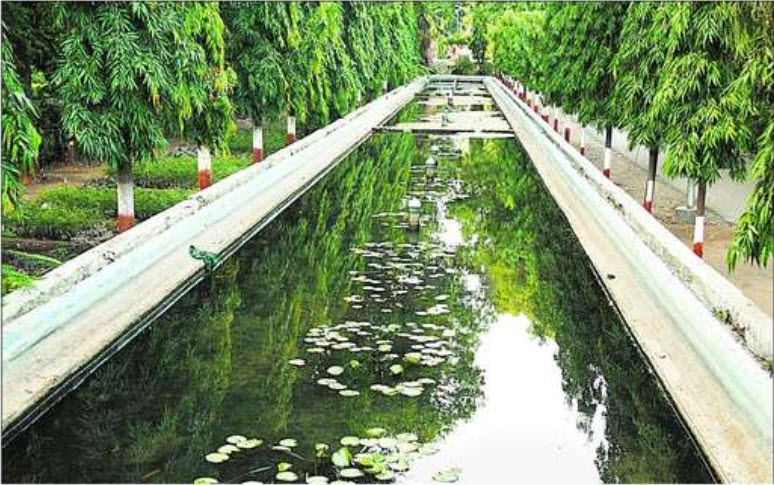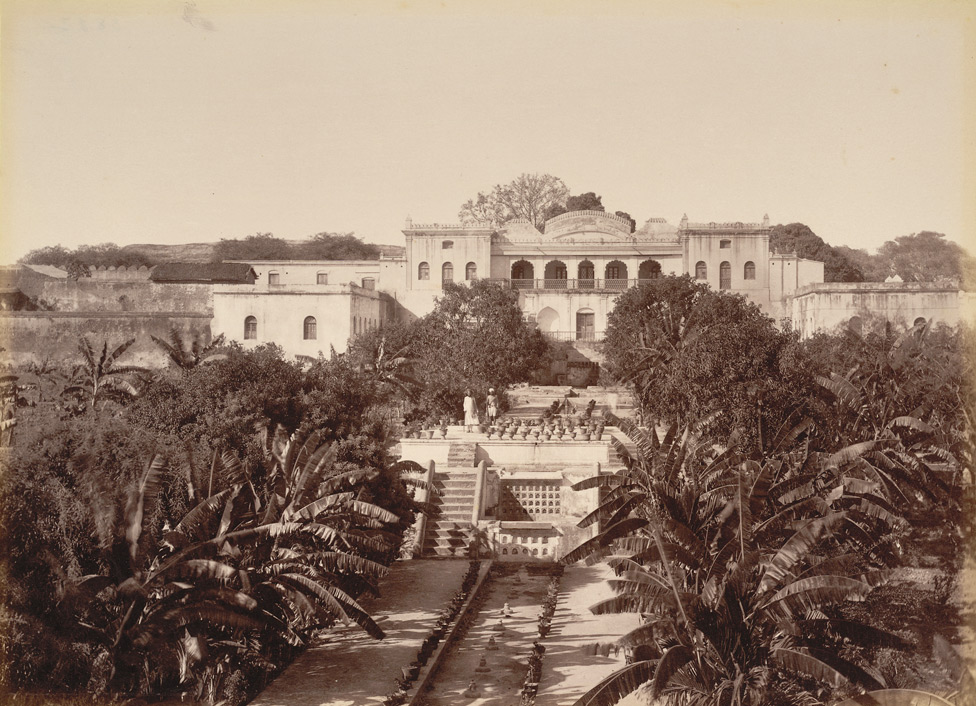|
Himayat Bagh
Himayat Bagh is a 17th-century garden that now houses the Fruit Research Station and Nursery, which is a part of the Vasantrao Naik Marathwada Krishi Vidyapeeth, Parbhani (Maharashtra). It is located near Delhi Gate in Rauza Bagh area of Aurangabad. It is a sprawling complex spread over , naturally green and in the olden days it was known as the Mughal Garden. Mughal era In Aurangzeb's time, Khizri Talao extended the whole length of the northern wall, (extending from present day Salim Ali Lake till Begumpura / Makbara) but the exhalation and dampness proved unhealthy and Aurangzeb ordered the portion immediately in front of his palace (Kila-e-Ark) to be filled in and converted into fields. This reclaimed portion was later developed into Mughal garden, (now known as Himayat Bagh) by one of the officials of Aurangzeb's court, with many fruit-bearing trees of different varieties for the royal court and its officials. Barra Darri Himayat Bagh also houses the Barra Darri which w ... [...More Info...] [...Related Items...] OR: [Wikipedia] [Google] [Baidu] |
Gates In Aurangabad, Maharashtra
The Gates of Aurangabad distinguish it from several other medieval cities in India. Each of the 52 gates have a local history or had individuals linked with it. Out of the 52, only four main and nine subordinate gates have survived, the most famous, oldest and biggest of them being the Bhadkal Gate near the Naukhanda Palace of Nizams. List of gates bhadkal.jpg, Bhadkal Gate delhigate1.jpg, Delhi Gate rangeen.jpg, Rangeen Gate roshangate.jpg, Roshan Gate barapulla.jpg, Barapulla Gate paithangate.jpg, Paithan Gate Mecca gate aurangabad.jpg, Mecca Gate kaala.jpg, Kaala Gate, jaffar.jpg, Jaffar Gate naubat.jpg, Naubat Gate mahmood_gate.jpg, Mahmud Gate Makai_gate.jpg, Makai Gate Bhadkal Gate.JPG, Bhadkal Gate #Delhi Gate # Rangeen Darwaza # Islam Darwaza (kat-Kat Gate) # Roshan Gate or (Jalna Gate) # Barapulla Gate # Paithan Gate # Khaas Gate # Jaffar Gate # Quil-e-Ark (Naubat Darwaza) # Kaala Gate # Mahmud Gate # Begum Darwaza # Makai Gate (Mecca Gate) # Bhadkal Gate # Chhota Bha ... [...More Info...] [...Related Items...] OR: [Wikipedia] [Google] [Baidu] |
Aurangabad Maharashtra
Aurangabad ( is a city in the Indian state of Maharashtra. It is the administrative headquarters of Aurangabad district and is the largest city in the Marathwada region. Located on a hilly upland terrain in the Deccan Traps, Aurangabad is the fifth-most populous urban area in Maharashtra with a population of 1,175,116. The city is known as a major production center of cotton textile and artistic silk fabrics. Several prominent educational institutions, including Dr. Babasaheb Ambedkar Marathwada University, are located in the city. The city is also a popular tourism hub, with tourist destinations like the Ajanta and Ellora caves lying on its outskirts, both of which have been designated as UNESCO World Heritage Sites since 1983. Other tourist attractions include the Aurangabad Caves, Devagiri Fort, Grishneshwar Temple, Jama Mosque, Bibi Ka Maqbara, Himayat Bagh, Panchakki and Salim Ali Lake. Historically, there were 52 Gates in Aurangabad, some of them extant, because ... [...More Info...] [...Related Items...] OR: [Wikipedia] [Google] [Baidu] |
Aurangzeb
Muhi al-Din Muhammad (; – 3 March 1707), commonly known as ( fa, , lit=Ornament of the Throne) and by his regnal title Alamgir ( fa, , translit=ʿĀlamgīr, lit=Conqueror of the World), was the sixth emperor of the Mughal Empire, ruling from July 1658 until his death in 1707. Under his emperorship, the Mughals reached their greatest extent with their territory spanning nearly the entirety of South Asia. Widely considered to be the last effective Mughal ruler, Aurangzeb compiled the Fatawa 'Alamgiri and was amongst the few monarchs to have fully established Sharia and Islamic economics throughout South Asia.Catherine Blanshard Asher, (1992"Architecture of Mughal India – Part 1" Cambridge university Press, Volume 1, Page 252. Belonging to the aristocratic Timurid dynasty, Aurangzeb's early life was occupied with pious pursuits. He held administrative and military posts under his father Shah Jahan () and gained recognition as an accomplished military commander. Aurang ... [...More Info...] [...Related Items...] OR: [Wikipedia] [Google] [Baidu] |
Salim Ali Lake Aurangabad
Salim, Saleem or Selim may refer to: People *Salim (name), or Saleem or Salem or Selim, a name of Arabic origin *Salim (poet) (1800–1866) *Saleem (playwright) (fl. 1996) *Selim I, Selim II and Selim III, Ottoman Sultans *Selim people, an ethnic group of Sudan *Salim, birth name of Mughal Emperor Jahangir Fictional characters * Saleem, in ''Corner Shop Show'' * Selim Bradley, in ''Fullmetal Alchemist'' * Pasha Selim, in Mozart's opera ''Die Entführung aus dem Serail'' * Saleem Sinai, in ''Midnight's Children'' * Salim Othman, in ''House of Ashes'' Places * Salim, Iran (other) * Salem, Ma'ale Iron, or Salim, Israel * Salim, Syria * Selim, Yenipazar, Turkey * Selim (District), Kars, Turkey ** Selim railway station * Salim, Nablus, West Bank Other uses * ''Salim'' (film), a 2014 Indian Tamil-language action thriller film * ''Saleem'' (film), a 2009 Telugu film *Selim (horse) (1802–1825), 19th-century Thoroughbred racehorse * Salim Group, an Indonesian conglomera ... [...More Info...] [...Related Items...] OR: [Wikipedia] [Google] [Baidu] |
Bibi Ka Maqbara
The Bibi Ka Maqbara (English: "Tomb of the Lady") is a tomb located in Aurangabad, Maharashtra, India. It was commissioned in 1660 by the Mughal emperor Aurangzeb in the memory of his wife Dilras Banu Begum (posthumously known as Rabia-ud-Daurani) and is considered to be a symbol of Aurangzeb's 'conjugal fidelity'. It bears a striking resemblance to the Taj Mahal, the mausoleum of Aurangzeb's mother, Mumtaz Mahal. Aurangzeb was not much interested in architecture though he had commissioned the small, but elegant, Pearl Mosque at Delhi. Bibi Ka Maqbara is the second largest structure that Aurangzeb has built, the largest being the Badshahi Mosque. The comparison to the Taj Mahal has often obscured its very own considerable charm. Due to the strong resemblance, it is also called the ''Dakkhani Taj'' (Taj of the Deccan). Bibi Ka Maqbara is the "principal monument" of Aurangabad and its historic city. An inscription found on the main entrance door mentions that this mausoleum was d ... [...More Info...] [...Related Items...] OR: [Wikipedia] [Google] [Baidu] |
Himayat Bagh
Himayat Bagh is a 17th-century garden that now houses the Fruit Research Station and Nursery, which is a part of the Vasantrao Naik Marathwada Krishi Vidyapeeth, Parbhani (Maharashtra). It is located near Delhi Gate in Rauza Bagh area of Aurangabad. It is a sprawling complex spread over , naturally green and in the olden days it was known as the Mughal Garden. Mughal era In Aurangzeb's time, Khizri Talao extended the whole length of the northern wall, (extending from present day Salim Ali Lake till Begumpura / Makbara) but the exhalation and dampness proved unhealthy and Aurangzeb ordered the portion immediately in front of his palace (Kila-e-Ark) to be filled in and converted into fields. This reclaimed portion was later developed into Mughal garden, (now known as Himayat Bagh) by one of the officials of Aurangzeb's court, with many fruit-bearing trees of different varieties for the royal court and its officials. Barra Darri Himayat Bagh also houses the Barra Darri which w ... [...More Info...] [...Related Items...] OR: [Wikipedia] [Google] [Baidu] |
Aurangabad Water System
Neher water system provided clean water for the people of Aurangabad and its suburbs. It was created by Malik Ambar who founded the town under the name Khadki and was later expanded by Aurangzeb to facilitate the military activity that became prevalent under Mughal rule during the 17th century. History The first aqueduct in Aurangabad was designed in 1612 by Malik Ambar to address the shortage of water caused by the lack of reservoirs and natural water reserves in the area. Despite the surrounding landscape, which made it difficult to construct the aqueducts' supporting pillars, the construction went ahead. The reason for the construction of the aqueduct was the discovery of a subterranean water supply in the mountainous valleys north of Aurangabad. The consequent construction of the waterway provided a stable water supply for a population of around seven lakhs (around seven hundred thousand people), with the city of Aurangabad receiving enough fresh water to prevent the shorta ... [...More Info...] [...Related Items...] OR: [Wikipedia] [Google] [Baidu] |
Tourist Attractions In Aurangabad, Maharashtra
Aurangabad is a historic city in Maharashtra state of India. The city is a tourist hub, surrounded by many historical monuments, including the Ajanta Caves and Ellora Caves, which are UNESCO World Heritage Sites, as well as Bibi Ka Maqbara and Panchakki. The administrative headquarters of the Aurangabad Division or Marathwada region, Aurangabad, is said to be a ''City of Gates'' and the strong presence of these can be felt as one drives through the city. In 2010, the Maharashtra Tourism Minister declared Aurangabad to be the tourism capital of Maharashtra. It is also one of the fastest-growing cities in the world. History of Aurangabad The city was founded in 1610 by Malik Ambar, the Prime Minister of Murtaza. Nizam Shah of Ahmadnagar on the site of a village called Khadki. He made it his capital and the men of his army raised their dwellings around it. Within a decade Khadki grew into a populous and imposing city. Malik Ambar died in 1626. He was succeeded by his son Fa ... [...More Info...] [...Related Items...] OR: [Wikipedia] [Google] [Baidu] |
Gardens In India
Mughal gardens are a type of garden built by the Mughals. This style was influenced by the Persian gardens particularly the Charbagh structure, which is intended to create a representation of an earthly utopia in which humans co-exist in perfect harmony with all elements of nature. Significant use of rectilinear layouts are made within the walled enclosures. Some of the typical features include pools, fountains and canals inside the gardens. Afghanistan, Bangladesh, India, and Pakistan have a number of Mughal gardens which differ from their Central Asian predecessors with respect to "the highly disciplined geometry". History The founder of the Mughal empire, Babur, described his favourite type of garden as a charbagh. The term '' bāgh'', ''baug'', ''bageecha'' or ''bagicha'' is used for the garden. This word developed a new meaning in South Asia, as the region lacked the fast-flowing streams required for the Central Asian charbagh. The Aram Bagh of Agra is thought to have ... [...More Info...] [...Related Items...] OR: [Wikipedia] [Google] [Baidu] |





